Gujarat Board GSEB Textbook Solutions Class 12 Biology Chapter 2 Sexual Reproduction in Flowering Plants Textbook Questions and Answers, Additional Important Questions, Notes Pdf.
Gujarat Board Textbook Solutions Class 12 Biology Chapter 2 Sexual Reproduction in Flowering Plants
GSEB Class 12 Biology Sexual Reproduction in Flowering Plants Text Book Questions and Answers
Question 1.
Name the parts of an angiosperm flower in which development of male and female gametophyte takes place.
Answer:
Pollen grain is the starting point of male gametophytic generation. After pollination the pollen grains germinate to produce male gametes or sperms.
Female gametophyte or embryo sac is developed inside the ovule, in the nucleus.
![]()
Question 2.
Differentiate between microsporogenesis and megasporogenesis. Which type of cell division occurs during these events? Name the structures formed at the end of these two events.
Answer:
| Microsporogenesis | Megasporogenesis |
| 1. The process of formation of microspores from pollen mother cell through meiosis is called microsporogenesis. 2. Pollen grains are formed at the end of this event. Occurs inside the pollen sac of the anther. |
1. The process of formation of megaspores from megaspore mother cells through meiosis is called megaspore -genesis.
2. Egg is, produced inside the embryo sac at the end of this event. |
Question 3.
Arrange the following terms in the correct developmental sequence: Pollen grain, sporogenous tissue, microspore tetrad, pollen mother cell, male gametes.
Answer:
Sporogenous tissue, pollen mother cell, microspore tetrad, pollen grain and male gametes.
Question 4.
What is meant by monosporic development of female gametophyte?
Answer:
In monosporic type of embryo sac, one of the spore tetrads is functional which is used for the development of female gametophyte or embryo sac.
![]()
Question 5.
What are chasmogamous flowers? Can cross-pollination occur in cleistogamous flowers? Give reasons for your answer.
Answer:
There are 2 types of flowers present in plants namely oxalis and viola chasmogamous and cleistogamous flowers. Chasmogamous flowers have exposed anthers and stigma similar to the flowers of other species.
Cross-pollination cannot occur in cleistogamous flowers. This is because cleistogamous flowers never open at all. Also, the anther and the stigma lie close to each other in these flowers. Hence only self-pollination is possible in these flowers.
Question 6.
With a neat, labelled diagram, describe the parts of a typical angiosperm ovule. Arts, Antipodals
Answer:
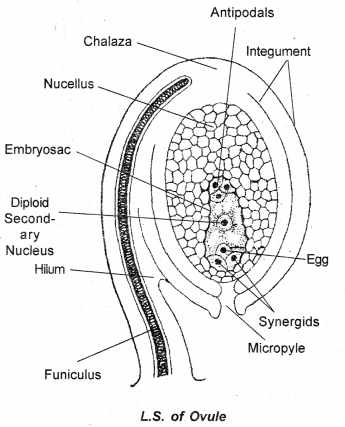
The Pistil, Megasporangium (ovule), and Embryo sac:
The gynoecium represents the female reproductive whorl of the flower composed of carpels. Each carpel has three parts viz. ovary, style, and stigma.
The pistil represents the female reproductive part of the flower. If an ovary is formed by a single carpel, it is called the monocarpellary pistil, if, by two carpels, it is called bicarpellary. When there are more than two carpels, it is called multicarpellary. If the carpels are fused together, it is called syncarpous. If they are free from one another, it is called apocarpous.
The Megasporangium or ovule:
The ovule is a small oval structure attached to the placenta by a short stalk. The stalk of the ovule is called funicle or funiculus. The point of attachment of funiculus to the body of ovule is called hilum. The parenchymatous tissue inside the ovule is called the nucellus which is enclosed by one or two protective layers called integuments. The integument leaves a pore at the top called micropyle.
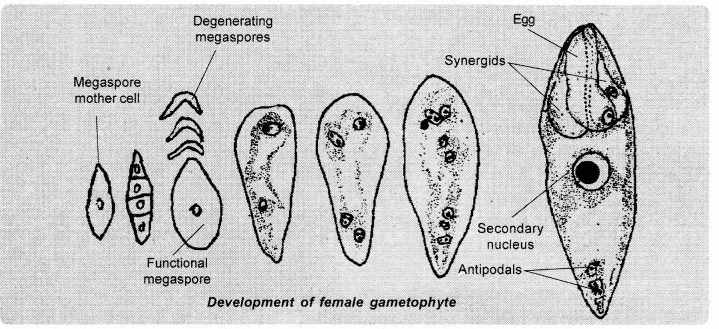
![]()
The basal region of the ovule from where the integuments originate is known as the chalaza. Within the nucellus the embryosac or female gametophyte is seen. The embryosac contains 8 nuclei – 3 at the micropylar end forms the egg apparatus consists of central egg and two synergids. Three cells at the chalazal end form antipodals. A diploid secondary nucleus is seen at the centre of embryosac. P. Maheswari, the father of angiosperm embryology in India, classified the female gametophyte of flowering plants into three main types based on the number of megaspore nuclei taking part in the development. They are monosporic embryosac, bisporic embryosac and tetrasporic embryosac.
Usually a single hypodermal nucellar cell, primary archesporial cell is differentiated at the apex below the epidermis. The primary archesporial cell divides periclinally to form an outer parietal or wall cell and an inner primary sporogenous cell. The primary sporogenous cell directly behaves as a single megaspore mother cell.
Usually the diploid spore mother cell undergoes reduction division (meiosis) and gives rise to four megaspores which are arranged in a linear tetrad fashion. The process of formation of megaspore from megaspore mother cell is known as megasporogenesis. Out of the four megaspores the three upper megaspores at the micropylar end degenerate and disappear. The remaining one at the chalazal end becomes the functional megaspore. It greatly enlarges and forms the female gametophyte or embry osac. The functional megaspore enlarges and absorbs food from the nucel- lus.
The haploid nucleus undergoes three repeated mitotic divisions to form eight nucleate female gametophyte or embryosac. Female gametophyte is usually 8 nucleate type (1 egg cell, 2 synergids and 3 antipodals). If the embryosac is developed from a uninucleate megaspore, it is known as mono- sporic embryosac development (polygonal type).
After the first division, the two daughter nuclei move towards the opposite poles of the cell. These daughter nuclei again get divided by two more successive divisions and form eight nuclei, four nuclei at the micropylar end and four at the chalazal end. One of these nuclei moves from each pole towards the centre (polar nuclei) and fuses to form a single diploid secondary nucleus.
The three cells at the micropylar end of the embryosac then form the egg apparatus which consists of central large egg and two synergids. The three cells at the chalazal end form antipodals. A fully developed embroyosac with nucellus, integuments and funiculus together constitute mature ovule.
![]()
Question 7.
With a neat diagram explain the 7-celled, 8-nucleate nature of the female gametophyte.
Answer:
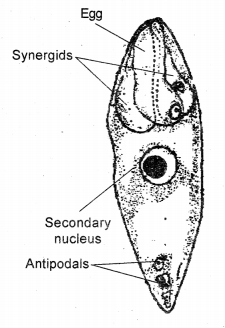
Question 8.
Mention two strategies evolved to prevent self-pollination in flowers.
Answer:
- Dichogamy: Maturation of anther and stigma of a flower at different times. Therefore self pollination is not possible in bisexual flowers.
- Dicliny: (unisexually). The stamens and carpels occur in different flowers.
- Self sterility: The pollen grains of a bisexual flower are not able to develop its growth on the stigma of the same flower.
Question 9.
What is self-incompatibility? Why does self-pollination not lead to seed formation in self-incompatible species?
Answer:
Self-incompatibility is a genetic mechanism in angiosperm that prevents self-pollination. It develops genetic incompatibility between individuals of the same species or between the individuals of different species.
The plants which exhibit this phenomenon have the ability to prevent germination of pollen grains and thus prevents the growth of the pollen tube on the stigma of the flower. This prevents the fusion of the gametes along with the development of the embryo. As a result, no seed formation takes place.
![]()
Question 10.
What is bagging technique? How is it useful in a plant breeding programme?
Answer:
The covering of bisexual flowers after emasculation is called bagging.
This is useful for preventing self-pollination or contamination by unwanted pollen grains.
Question 11.
What is triple fusion? Where and how does it take place? Name the nuclei involved in triple fusion.
Answer:
Triple fusion is the fusion of the male gamete with 2 polar nuclei inside the embryo sac of the angiosperm. When pollen grains fall on the stigma, they germinate and give rise to the pollen tube that passes through the style and enters into the ovule.
After this, the pollen tube enters between one of the synergids and releases 2 male gametes there. Out of these 2 male gametes, one gamete fuses with nucleus of the egg cell and forms zygote (syngamy). The other male gametes fuse with 2 polar nuclei in the centre to form a triploid primary endosperm nucleus. Since this process involves the fusion of 3 haploid nuclei, it is known as triple fusion. It results in the formation of the endosperm.
Question 12.
Differentiate between:
a. hypocotyl and epicotyl
b. coleoptile and coleorhiza
c. integument and testa
d. perisperm and pericarp
Answer:
a. Hypocotyl and epicotyl:
The portion of embryonal axis below the level of cotyledons is called hypocotyl and the portion seen above the level of cotyledons is epicotyl.
b. Coleoptile and coleorrhiza:
In the embryonal axis of monocot just above the level of attachment of scutellum, the epicotyl has a shoot apex and a few leaf primordia enclosed in a hollow foliar structure called the coleoptile.
In monocot embryonal axis the lower end has the radicle and root cap enclosed in an undifferentiated sheath called coleorrhiza.
c. Integument and testa
The covering of ovule is called integument. After fertilisation the integument becomes seed coat or test.
d. Perisperm and pericarp
The remnants of nucellus seen inside the seed are called perisperm. The fruit wall or ovary wall is called the pericarp.
Question 13.
Why is apple called false fruit? Which part of the flower forms the fruits?
Answer:
The apple is not produced from ovary and so it is called false fruit. It is produced from the thalamus of flower. After fertilisation thalamus becomes swollen and fleshy edible part. Usually the ovary of the flower after fertilisation develops into fruit.
![]()
Question 14.
What is meant by emasculation? When and why does a plant breeder employ this technique?
Answer:
Emasculation is the process of removing anthers from bisexual flowers without affecting the female reproductive part (pistil). Emasculation is performed by plant breeders in bisexual flowers to obtain the desired variety of a plant by crossing a particular plant with the desired pollen grain. After removing the anthers, the flowers are covered with a bag before they open. This ensures that the flower is pollinated by pollen grains obtained from desirable varieties only.
Later, the mature, viable, and stored pollen grains are dusted on the bagged stigma by breeders to allow artificial pollination to take place and obtain the desired plant variety.
Question 15.
If one can induce parthenocarpy through the application of growth substances, which fruits would you select to induce parthenocarpy and why?
Answer:
Grapes, oranges, and pomegranates are commonly used to produce parthenocarpy. Because these fruits are economically important.
Question 16.
Explain the role of the tapetum in the formation of pollen-grain walls.
Answer:
Tapetum is the innermost wall layer of the anther. The main function of the tapetum is to provide nutrition for the developing pollen grains.
Question 17.
What is apomixis and what is its importance?
Answer:
Apomixis is the formation of seeds by asexual processes. Apomixis comprises an ensemble of developmental processes that together alter the reproductive functions in the ovule of flowering plants, converting the sexual process to an asexual one.
Potential impacts of apomixis are
- Propagation of hybrid seed directly by the farmer. Seed from an apomictic hybrid will not lose its genetic makeup through the sexual crossing and thus will “breed true”.
- Tuber crops are currently vegetatively propagated, eg. Cassava, Potato, Sweet potato, and Yams. This will result in the elimination or reduction of propagule-borne disease, a substantial increase in germplasm flow, and the expansion of potential growing regions.
![]()
GSEB Class 12 Biology Sexual Reproduction in Flowering Plants Additional Important Questions and Answers
Question 1.
Name the protective substance present on the pollen envelope to tide over the adverse conditions. [CBSE 98]
Answer:
Sporopollenin.
Question 2.
Given below is the picture of pollen germination. Observe it and answer the following questions.
a. When does the pollen germination begin?
b. What is the role of the two male gametes in angiosperm fertilization?
c. What is the result of fertilization?
Answer:
a. When the pollen grains fall on the stigma, pollen germination begins,
b. One male gamete fuses with the egg and the other male gamete fuses with the secondary nucleus,
c. Zygote and primary endosperm nucleus.

![]()
Question 3.
What technical term is applied to fruits formed without fertilization?
Answer:
Parthenocarpy
Question 4.
Endothecium, Tapetum, Epidermis, Middle layers. These are the parts of another wall.
a. Arrange them in an order according to the occurrence in the anther wall.
b. What is the function of tapetum?
Answer:
a. Epidermis, endothecium, middle layers, tapetum.
b. It becomes the nutritive tissue for developing pollen grains,
![]()
Question 5.
List the general characteristics of the pollen grains of wind-pollinated plants.
Answer:
The pollen grains are smooth, dry, light, non-sticky, and maybe winged. [CBSE – 2K]
Question 6.
Observe the diagram
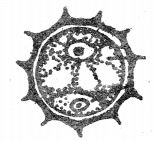
a. Copy this diagram in your answer sheet and mark the following parts, intine, exine, vegetative cell, generative nucleus.
b. What is this structure?
c. What is the ploidy of the given structure?
Answer:
a.
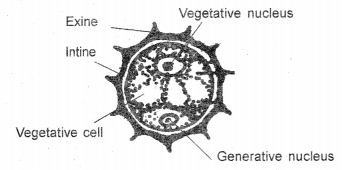
b. This is a mature pollen grain
c. The structure is haploid.
![]()
Question 7.
Observe the given diagram

a. What is the structure shown here?
b. How many nuclei were there in its young stage?
c. What are the upper three cells together called?
Answer:
a. Embryosac
b. Eight nuclei
c. Egg apparatus
Question 8.
Fertilization in Angiosperms is called double fertilization because here two male gametes take part in fertilization.
a. Which cells do this male gamete fertilize?
b. What are the products of fertilization?
c. Explain the ploidy of the two products.
Answer:
a. One male gamete fuses with the egg and the other male gamete fuses with the secondary nucleus.
b. The products are zygote and primary endosperm nucleus.
c. Zygote is diploid and primary endosperm nucleus is triploid
![]()
Question 9.
State the function of a suspensor.
Answer:
Pushes the developing embryo into the endosperm for the absorption of nutrients.
Question 10.
Names of some parts of the female reproductive structure before fertilization, are given. Match them with the modified part after fertilization.
| A | B |
| Ovule | Zygote |
| Integument of ovule | Endosperm |
| Ovary | Seed |
| Ovum | Fruit |
| Secondary nucleus | Seed coat |
Answer:
| A | B |
| Ovule | Seed |
| Integument of ovule | Seed coat |
| Ovary | Fruit Seed |
| Ovum | Zygote |
| Secondary nucleus | Endosperm |
![]()
Question 11.
Cleistogamous flowers’ are invariably autogamous. Explain.
Answer:
Cleistogamous flowers do not open at all. The pollen grains from the anther of the same flower pollinate the stigma. There is no chance of cross-pollination. Thus cleistogamous flowers are invariably autogamous.
Question 12.
Compare the given pair and fill up the blanks.
a. Grasses : Wind pollination :: Zostera : ……………
b. Fragrant flower : Insect :: Light and nonsticky pollen : ………………
Answer:
a. Water b. Wind
Question 13.
Water is considered as the pollinating agent in some plants. Name any two water-pollinated plants.
Answer:
Vallisneria, Zostera
![]()
Question 14.
Autogamy, geitonogamy, and xenogamy are the three types of pollination based on the source of pollen.
You have a monoecious and dioecious plant in your garden. Which among the above said pollination do not occur in each plant?
Answer:
Monoecious – Autogamy
Dioecious – Autogamy and geitonogamy
Question 15.
Continuous self-pollination results in inbreeding depression. Flowering plants have developed many devices to discourage self-pollination and to encourage cross-pollination. Explain any four such mechanisms.
Answer:
- Either pollen or stigma matures first.
- Anther and stigma are placed at different positions.
- Self-incompatibility
- Production of monoecious and dioecious condition
![]()
Question 16.
Removal of anthers from the flower bud of female parents is an important step in hybridisation.
a. Name the step and explain the purpose.
b. What is the importance of “bagging?
Answer:
a. Emasculation: It is done to avoid self-pollination.
b. ‘Bagging’ protects the stigma from contamination of unwanted pollen grains.
Question 17.
The endosperm is the nutritive tissue of the growing embryo. Inside a tender coconut two types of endosperms are seen. Name the type of endosperms and the structure that represents each type.
Answer:
a. Free nuclear endosperm – Coconut water
b. Cellular endosperm – White kernel
Question 18.
The embryo is the structure developed from a zygote, after many divisions. The embryo undergoes many changes until it becomes embryo proper.
a. Give the structure of a mature embryo.
Answer:
a. The mature embryo has an axis of two cotyledons in dicots and one cotyledon in monocot. The upper end of the embryo axis is called the plumule and the lower end is called the radicle.
![]()
Question 19.
All fruits are produced from the ovary of a fertilized flower. Write an exception to this statement and explain.
Answer:
In certain plants, some parts of a flower in addition to the ovary also participate in the development of fruits. Such fruits are called ‘false fruits’.
e. g. In the apple, the thalamus is developed to form the fleshy structure.
Question 20.
Fruits are formed for the protection of seeds. But certain fruits are produced without seed.
a. What are these fruits called?
b. What chemicals are used to induce the production of seedless fruits?
c. Give two examples of naturally occurring seedless fruits.
Answer:
a. Parthenocarpic fruits
b. Indole Acetic Acid, Gibberellic acid etc. are used to induce partheno- carpy
c. Banana and grapes
![]()
Question 21.
Find the relation of the plant ‘Lupinus arcticus’ with ‘seed dormancy’.
Answer:
The plant has the longest recorded dormancy period of 10000 years.
Question 22.
Apomixis is a form of asexual reproduction that mimics sexual reproduction. Is the statement correct? Explain.
Answer:
Yes. Apomixis is a special mechanism of producing seeds without fertilization. So it is asexual reproduction. But the diploid cell of the ovule develops into embryo without fertilization. So it mimics sexual reproduction.
Question 23.
Apomixis will reduce the cultivation cost of hybrid plants. Explain.
Answer:
Hybrid seeds are costly and must be produced every year because the seeds from hybrids do not give the same characters. If these hybrids are made into apomicts, there is no segregation of characters and the farmers can use the seeds of hybrids.
![]()
Question 24.
Give the technical terms of the following explanation.
a. Formation of seedless fruits without fertilization.
b. Organisms are formed from unfertilized female gamete.
Answer:
a. Parthenocarpy b. Parthenogenesis
Question 25.
With the help of labelled diagrams, depicting the stages of a microspore maturing into a pollen grain.
Answer:
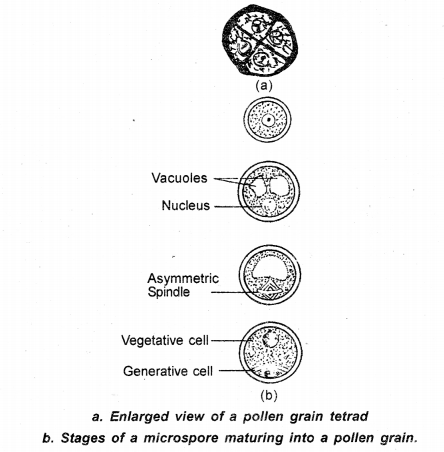
![]()
Question 26.
In the adjacent figure of a typical dicot embryo, label the parts (i), (ii), and (iii). State the function of each of the labelled parts.
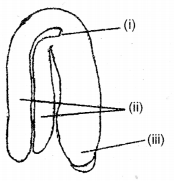
Answer:
i. Plumule
ii. Cotyledons
iii. Radicle
i. Plumule develops into a shoot system.
ii. Cotyledons function as first leaves as well as supply food to the developing embryo.
iii. Radicle develops into the root system.
Question 27.
How does the development of male gametophyte or pollen take place?
Answer:
The haploid microspore (pollen) is the pioneer structure of the male gametophyte. It begins to germinate before it is shed. Microspore nucleus at the time of germination moves to the place adjacent to the spore wall. It then divides into two cells – one larger cell called a vegetative cell and a smaller cell called a generative cell. The latter is variable in form and has denser cytoplasm. The exine ruptures near the germ pore and a delicate tubular structure is formed called a pollen tube and the tube nucleus shifts into it. Meanwhile, the generative cell divides into two male gametes.
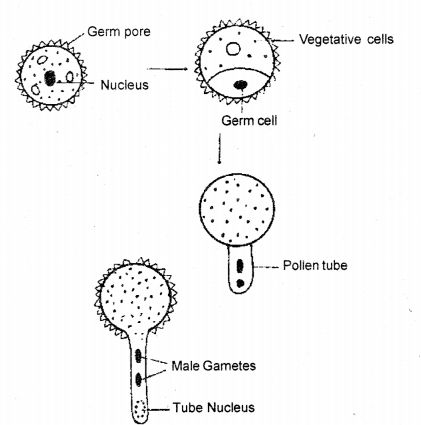
![]()
Question 28.
Give the structure of self-pollinated flower, cross-pollinated, and cleistogamous flower. Differentiate between self-pollination and cross pollination.
Answer:
a. Self-pollinated flowers, b. Cross pollinated flowers, c. Cleistogamous flowers
Self-pollination:
- Migration of pollen grains from the anther to the stigma of the same flower (or same plant) is called self-pollination
- Mode of pollination is always by touch.
- Anthers and stigma mature at the same time and lie close to each other.
- Mo chances of new varieties. Migration of pollen grains from the anther to the stigma of another flower of another plant belong ing to the same species is called cross-pollination
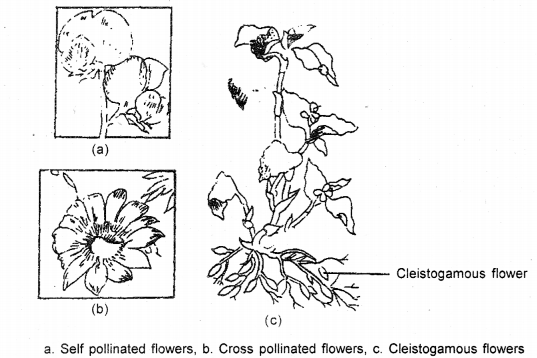
Cross-pollination:
- Migration of pollen grains from anther to the stigma of another flower of another plant belonging to the same species is called cross-pollination.
- Modes of pollination are by wind, water, or animals.
- Anthers and stigma may mature at different times, and not essentially lie, in proximity.
- Variations occur at every new generation and thus leads to evolution.
![]()
Question 29.
Explain the role of the tapetum in the formation of pollen grain wall.
Answer:
Tapetum is the innermost wall of the microsporangium. The tapetal cells may be uni-, bi- or multinucleate and possess dense cytoplasm. The various roles played by tapetum are
- Secretion of hormones and various enzymes.
- Transportation of nutrients to the developing pollen grains.
- Production of ubisch bodies coated with sporopollenin cause exine thickening.
- Secretion of pollenkit (oily substance) outside mature pollen,
- Secretion of proteins for pollen to be compatible during fertilization.
Question 30.
Draw a labelled diagram of L.S of pistil
Answer:
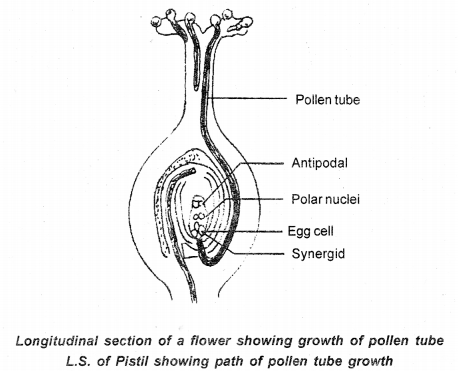
Question 31.
Differentiate between non-albuminous and albuminous seeds with examples.
Answer:
- Non-albuminous seeds have no residual endosperm as it is completely consumed during embryo development. Eg: Pea, groundnut.
- Albuminous seeds retain, a part of the endosperm as it is not completely used up during embryo development. Eg: Wheat, maize, barley, castor.
![]()
Question 32.
Define pollination.
Answer:
Pollination is the transfer of pollen grains from anther to the stigma of the flower.
Question 33.
Mention the scientific term used, for modified form of reproduction in which seeds are formed without fusion of gametes.
Answer:
The scientific term used for modified form of reproduction in which seeds are formed without fusion of gametes (fertilisation) is apomixis.
Question 34.
Describe the structure of a typical embryo sac found in flowering plants. Why is it generally referred to as monosporic?
Answer:
The process of development of a gametophyte or embryo sac from a megaspore is called megagametogenesis. The nucleus of megaspore undergoes three successive mitotic divisions forming high haploid nuclei. The megaspore enlarges into an oval shaped structure called embryo sac. The polar nuclei may fuse to form a secondary nucleus. It is a monosporic type of development and the embryo sac is termed monosporic
Question 35.
What is funiculus?
Answer:
The funiculus is the stalk of the ovule.
![]()
Question 36.
Describe the structure of a typical embryo sac found in a flowering plant. Why is it generally referred to as monosporic?
Answer:
A typical embryo sac is 8 nucleate and 7 celled. Six of the eight nuclei become surrounded by cell walls and are organized into cells. Two of the nuclei, called polar nuclei remain in the centre of the large central cell. Three cells are grouped together at the micropylar end forming the egg apparatus. Of these, one is the female gamete and two are synergids; the synergids have special cellular thickening called filiform apparatus at the micropylar tip.
Question 37.
a. Draw a schematic labelled diagram of a fertilised embryo sac of an angiosperm.
b. Describe the stages in embryo development in a dicot plant.
Answer:
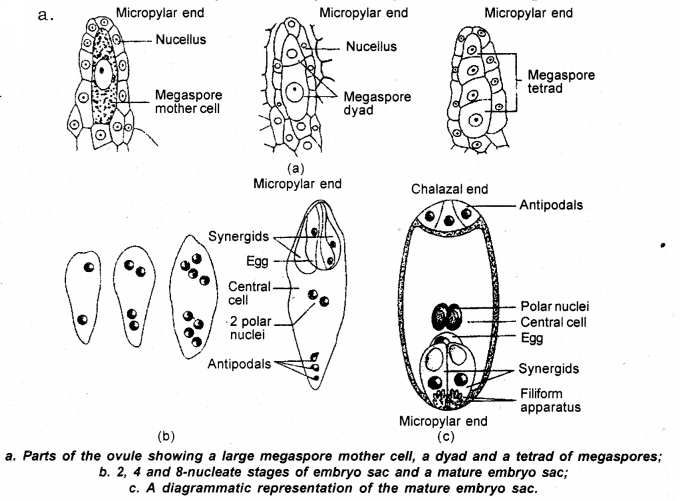
b. Embryo develops at the micropylar end of the embryo sac where the zygote is situated. Most zygotes divide only after a certain amount of endosperm is formed. This adaptation provides assured nutrition to the developing embryo. The later stages of embryo development (embryogeny) are similar in monocotyledons and dicotyledons.
In a dicotyledonous embryo, the zygote gives rise to the pre-embryo and subsequently to the globular, heard-shaped and mature embryo.
In the dicot seed, the embryo consists of an embryonal axis, two cotyledons, plumule, radicle or root tip. The root tip is covered with a root cap.
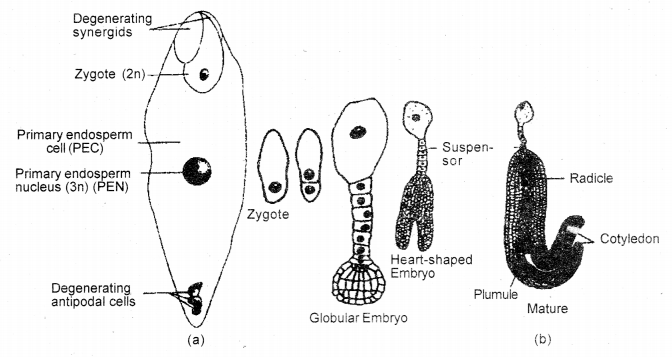
![]()
Question 38.
a. Draw a longitudinal sectional view of a typical anatropous ovule to show the site where double fertilization takes place. Label any four major parts of the ovule.
b. How do the male gametes that are present in the pollen groans reach the site mentioned by you import (a) to cause double fertilization?
Answer:
a.
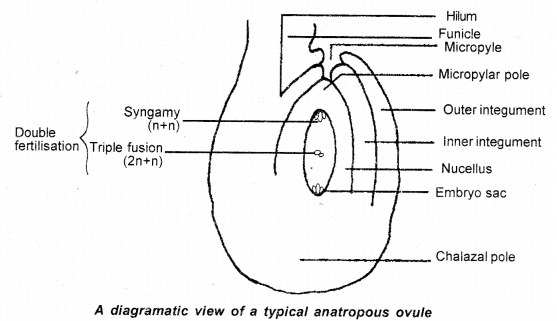
b. A diagrammatic view of a typical anatropous ovule
In the embryo sac double fertilization takes place.
The pollen tube releases the male gametes into the cytoplasm of the synergid.
The fusion of three haploid nuclei is termed triple fusion. Syn- gamy and triple fusion takes place in the embryo sac. This phenomenon is termed double fertilization.
Question 39.
a. Draw the embryo sac of a flowering plant and label (i) central cell, (ii) chalazal end of the embryo sac, and (iii) synergids.
b. Name the cell that develops into the embryo sac and explain how this cell leads to the formation of the embryo sac. Also, mention the role played by the various cells of the embryo sac.
Answer:
a.
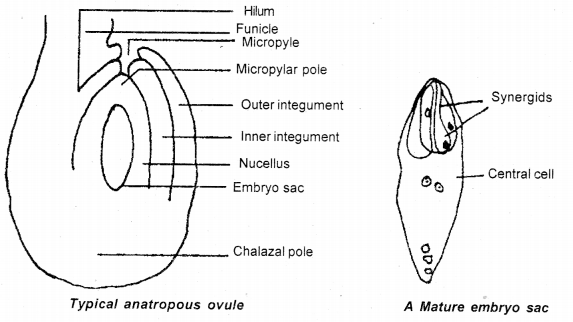
b. One of the nucellus cells develops into an embryo sac.
The process of formation of megaspores from the megaspore mother cell is called megasporogenesis.
The nucleus of the functional megaspore divides mitotically to form two nuclei which move to the opposite poles forming the 2 nucleate embryo sac. Again one more mitotic division results in the formation of 4 nucleate and later 8 nucleate stage of the embryo sac.
Two nuclei present in the central cell are called polar nuclei. Three cells grouped together at the micropylar end constitute the egg apparatus and synergid. Three cells at the chalazal end are called antipodals.
A typical angiosperm embryo sac at maturity though 8 nucleate is 7 celled.